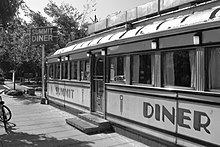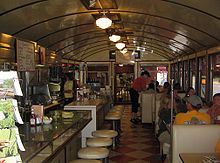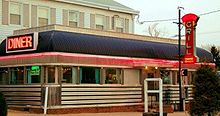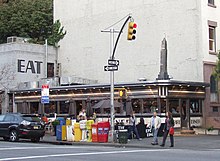Diner

A diner is a simple North American restaurant that is usually located outside of closed places and cities on highways and thus has the function of a motorway service station . The Diner has the late 19th century from mobile snack bars designed for discarded dining car of the railway used to in English dining car hot; from this came the abbreviation diner . Today's diners are small prefabricated buildings . "The food offer was limited for space reasons and moved between fast food and restaurant."
history

The diners developed from mobile snack bars at the end of the 19th century . A pioneer in the USA is a snack vendor named Walter Scott from Providence , Rhode Island , who converted a discarded railroad car in 1872 and used it to post himself in front of the Providence Journal offices in the evening because the restaurants nearby closed in the evening. He sold simple items like sandwiches and coffee. His idea turned out to be successful, so that imitators were soon found. Since 1880, Samuel Jones from Worcester , Massachusetts , manufactured dinner carts with seats especially for the snack bar, which were also mobile and allowed the operators to change locations. These early dinners were in larger cities. In 1905, Patrick Tierney began building stationary diners in New Rochelle , which only looked like the former dining car in terms of appearance and size. The meals offered were simple and inexpensive.
After the First World War , more and more diner operators settled in the suburbs of the cities and along the highways. In busy locations, these quick service restaurants were open 24/7, serving breakfast, lunch, and dinner. There were around 6,000 diners in the United States in the 1930s.
Until the Great Depression , most diner manufacturers and their customers were located in the northeastern United States. After the Second World War , when the economy returned to civilian production and the suburbs grew, dinners were seen as a cheap way to start a small business. During this time, numerous dinners were opened in the Midwest . From the 1970s, however, the diners were increasingly replaced by fast food chains such as McDonald’s , Burger King , Wendy's and Kentucky Fried Chicken . Some fast-food places like Dairy Queen are a mixture of old-style diners and modern fast-food restaurants .
architecture

Diners are usually narrow and elongated in shape, which allowed road transport to the restaurant location. The interior is dominated by the service counter, with a prep area along the back wall and tall chairs for customers to the front. Decoration habits changed over time. The dinners from the 1920s to 1940s featured Art Deco and Streamline elements or copied the interior of railroad dining cars (in fact, disused railway cars were used as dinners in a few cases). In the 1950s, stainless steel, glass blocks, and neon lights dominated the interior. Modern diners are designed more like normal restaurants, with some reminiscences of traditional diner architecture (usually stainless steel and Art Deco elements).
Cultural meaning
In television and cinema productions, dinners represent the period of growth and optimism in America in the 1950s. They are used as a place where young people meet after school and as an important part of a rendezvous. The cultural influence of the diner continues to this day. Many restaurants (including chains like Denny's ) have adopted the look of the 1950s diner, while the Waffle House chain has copied the interior architectural structure of the diners.

Diners are similar to the fast-food chains, places with recognition value , used for food and as a meeting place. The food and prices are usually fairly uniform (especially within a region), apart from areas with large immigrant populations, where foreign cuisine is often offered. Dinners are often open 24 hours, especially in cities, which makes them an integral part of the city's culture. In this context, over 20 diners in the state of Massachusetts were registered as Diners of Massachusetts MPS on the National Register of Historic Places .
Trivia
In parts of the states of New York , Ohio, and Pennsylvania , diners are often spelled Dinor . This affects an area approximately 50 miles radius around Erie , Pennsylvania. So far there is no scientific consensus about the origin of the different spelling.
literature
- Michael Karl Witzel: The American Diner. MBI Publishing, Osceola, WI 1998, ISBN 0-7603-0110-7
Individual evidence
- ↑ Diner, the . In: Duden online . Retrieved September 2, 2017.
- ↑ Diner. In: Alan Davidson: The Oxford Companion to Food. 2nd Edition. New York 2002.
- ↑ a b c Diners. In: Andrew F. Smith: The Oxford Encyclopedia of Food and Drink in America. New York 2004.
- ↑ a b Wolfgang König: History of the consumer society. Stuttgart 2000, p. 179.

